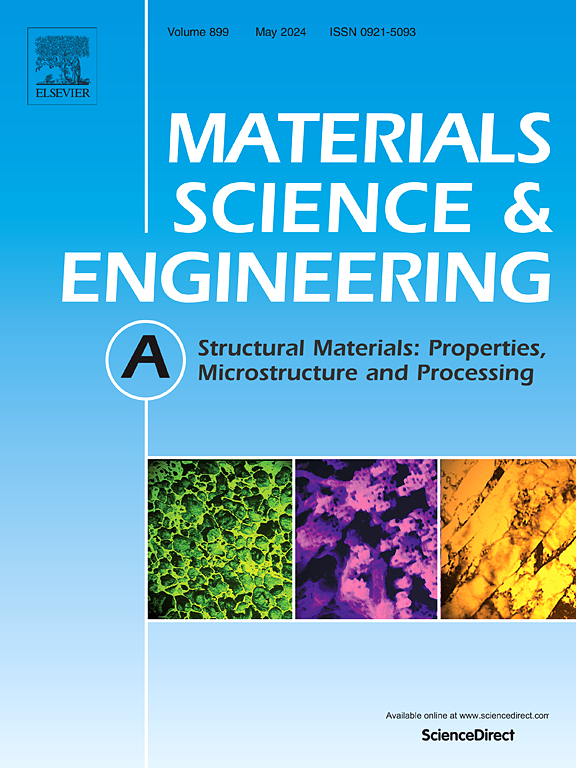层间滑移作用下变形Ti2AlC颗粒在铝基复合材料中的强度塑性协同效应
IF 6.1
2区 材料科学
Q1 MATERIALS SCIENCE, MULTIDISCIPLINARY
引用次数: 0
摘要
在本研究中,我们的重点是阐明变形颗粒在铝基复合材料上的强度和塑性协同作用机制。选择Ti2AlC增强剂,采用火花等离子烧结和热挤压法制备不同含量的变形颗粒增强复合材料。优选取向和最佳添加Ti2AlC颗粒的复合材料在15%拉伸应变下的抗拉强度为252 MPa,表现出良好的强度和塑性平衡。电子后向散射衍射(EBSD)得到的核平均取向偏差(KAM)图表明,大角度取向偏差主要分布在Ti2AlC内部,表明变形集中在颗粒内部。随着颗粒含量的增加,由KAM值估算的几何必要位错(GND)密度逐渐增大,表明颗粒变形促进了位错强化。变形的表面形貌表明,Ti2AlC颗粒主要是层间滑动变形,其织构对颗粒断裂行为有密切影响。探讨了不同体积分数下复合材料的载荷传递、晶粒细化和位错强化机理,分析了复合材料屈服强度的提高。结果表明:低含量时,位错强化以颗粒变形为主,高含量时,晶粒细化强化效果同样显著;复合材料的强度塑性协同效应主要是充分利用Ti2AlC颗粒的变形能力,促进多种强化机制的协同效应。本文章由计算机程序翻译,如有差异,请以英文原文为准。
Strength-plasticity synergy of deformed Ti2AlC particles in aluminum matrix composites via interlayer slip
In this study, we focus on clarifying the synergistic mechanism of strength and plasticity of deformed particles on aluminum matrix composites. Ti2AlC reinforcement was selected to prepare deformed particle reinforced composites with different contents by spark plasma sintering and hot extrusion process. The composite with preferred orientation and optimal addition of Ti2AlC particles demonstrates a tensile strength of 252 MPa with 15 % tensile strain, showing a good balance of strength and plasticity. The Kernel Average Misorientation (KAM) maps obtained by Electron Backscatter Diffraction (EBSD) analysis shows that high-angle misorientation is mainly distributed inside the Ti2AlC, indicating that the deformation is concentrated in the particles. With the increase of particle content, the geometrically necessary dislocation (GND) density estimated by the KAM values gradually increases, revealing that deformation of particles promotes dislocation strengthening. The deformed surface morphology reveals that the Ti2AlC particle is mainly deformed by interlayer sliding, and the texture of Ti2AlC has a close influence on the particle fracture behavior. In addition, the strengthening mechanisms of load transfer, grain refinement and dislocation are discussed for composites under different volume fractions to analyze the improvement of yield strength. The results demonstrate that dislocation strengthening caused by particle deformation dominates at low content, and the effect of grain refinement strengthening becomes equally significant at high content. The strength-plasticity synergistic effect of composites mainly makes full use of the deformation ability of Ti2AlC particles and promotes the synergistic effect of multiple strengthening mechanisms.
求助全文
通过发布文献求助,成功后即可免费获取论文全文。
去求助
来源期刊

Materials Science and Engineering: A
工程技术-材料科学:综合
CiteScore
11.50
自引率
15.60%
发文量
1811
审稿时长
31 days
期刊介绍:
Materials Science and Engineering A provides an international medium for the publication of theoretical and experimental studies related to the load-bearing capacity of materials as influenced by their basic properties, processing history, microstructure and operating environment. Appropriate submissions to Materials Science and Engineering A should include scientific and/or engineering factors which affect the microstructure - strength relationships of materials and report the changes to mechanical behavior.
 求助内容:
求助内容: 应助结果提醒方式:
应助结果提醒方式:


